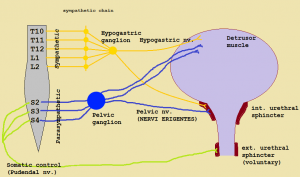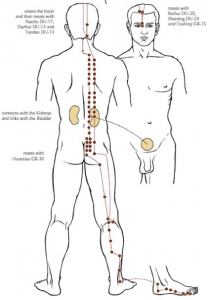Healthy life: Differential Diagnosis -Bladder pain & Spinal nerve) (966)
Healthy life: Differential Diagnosis -Bladder pain & Spinal nerve)
蘇鎮邦 (Christopher So):
舒整物理治療師 (Manipulative Physiotherapist) 人類工程師 (Ergonomist)
Recently, I had a 41 year old lady with severe bladder pain who called me for advice on a TENS machine. She had developed severe bladder pain 4 weeks ago. She consulted a GP who had done blood tests and an MRI with normal results. She was referred to a specialist who could not find any underlying problem. She was given a number of strong pain killers with no relief. She sought the opinion of another GP who was more sympathetic and thorough with his approach. Further tests and another MRI were done but nothing abnormal diagnosed. The GP suggested as a last resort to use a nerve blocker. However, he was conservative enough to suggest a trial with a TENS machine before the nerve blocker which might have undesirable side effects. Then, the patient contacted me. She also asked me whether I do acupuncture. I explained to her that I will try the interferential machine. If it works then she can get a TENS machine. Acupuncture works in a similar way to IFT (interferential therapy) and TENS through the Gate Theory.
Before she came, I reviewed the acupuncture meridian. The bladder meridian (Figure 1,2) goes up and down both sides of the spine. When she came, I did a thorough subjective examination. The main findings were she had irritable bowels 18 months ago when she had to go to Emergency and stayed in hospital for 3 days. It is now under control. This could have misled the GP and specialist to focus on her urinary system. 4 weeks ago, she developed severe bladder pain. She had to go to the toilet 20 – 30 times during the day and 6-7 times during the night. I confirmed twice with her that there is no finding of cancer before I treated her especially as it would include IFT which might spread existing cancer cells.
As a Manipulative Physiotherapist and an Ergonomist, I recognized that her work as a cake decorator and the recent high work load were likely causes of strain in her mid-back. Worse still, she told me that her house was auctioned and passed in a few weeks ago. She was under a lot of stress. Thus, I explained to her that I was quietly confident that the cause of her bladder pain might be referred from her back especially around T10 – L2. I asked her to have 3 treatments to confirm my suspicion. I cured her neck pain last year and she had confidence in me. Moreover, she had done all she could medically. She had nothing to lose to have her mid-back treated. Also, she was not keen to start the nerve blocker. It would be likely to make her pain into a chronic one and she may become dependent on the painkiller. As I expected, she had stiffness and pain T11-L1. After mobilisation and IFT, both stiffness and pain decreased significantly.
She insisted on coming back the next two days. On the following day which was Thursday, she came back and told me that last night she only needed to go to the toilet once. I told her that was promising but I could not rule out that it might be just a coincidence. I treated her with the same treatments and told her if it happened again that night then we were on the right track. To my relief, it happened again. She was relieved too. However, the next day was Saturday which was her open house day. She said she would ring me if she could come. She did not ring me until the following Wednesday. She came back saying it was 85% better. Her bladder was functioning pretty much normally. I discharged her and emphasized that she needed to do the back exercises for 4 more weeks 4 times a day. Then, she could reduce to 2 times a day as maintenance exercises.
I want to share with you this case study not because I want to show my ability to differentially diagnose her bladder problem. The most important purpose of this case study is to make practitioners aware of the need to exhaust every avenue to find the underlying cause of the problem before resorting to a pain killer, pain management, cognitive behavioural therapy or other so called holistic approaches which in all likelihood will turn this patient into a chronic pain patient.
However, I am aware of the extreme opposite to the holistic approaches mentioned above, in which certain professional practitioners attribute almost every pain or ailment as referred from the spine. A balanced approach is absolutely necessary with logical and systematic elimination of possible causes of various pain conditions.

(Figure 1)Spinal nerves supplying the bladder

(Figure)Bladder Meridian : meridianlouisville.blogspot.com
